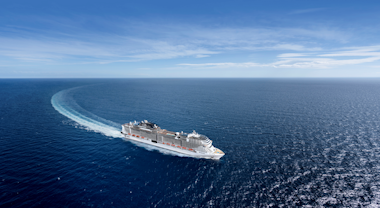Country or Region selection
Worldwide MSC International
Europe
MSC CRUISES’ UPCOMING SHIPS TO FURTHER COMPANY’S ENVIRONMENTAL COMMITMENT
08/02/2021• MSC Virtuosa and MSC Seashore to be equipped with cutting-edge technologies that minimise environmental footprint
• LNG-powered MSC World Europa to join fleet in 2022, work to begin on a second LNG ship in 2021
• MSC Cruises joins EU-backed CHEK Consortium to promote low-carbon shipping by combining energy technologies and innovative ship design
London, United Kingdom, 28 January 2021 – 2021 will see two new MSC Cruises ships come into service, MSC Virtuosa and MSC Seashore, the latest ships to be delivered as part of the Company’s long-term new builds programme. As every ship that joins the MSC Cruises fleet, these ships are being equipped with a wide range of latest-generation environmental technologies and equipment that will minimise their impact.
Both ships will feature hybrid exhaust gas cleaning systems (EGCS) and cutting-edge selective catalytic reduction systems (SCR), achieving a 98% reduction of sulphur oxide (SOx) emissions and reducing nitrogen oxide (NOx) emissions by 90%. Their wastewater treatment systems have been designed in line with the International Maritime Organization’s MEPC 227(64) Resolution and achieve purification standards that are higher than most wastewater treatment facilities ashore. As all MSC Cruises’ newbuilds, they will also be equipped with shore-to-ship power connectivity, allowing them to connect to local power grids while at berth at ports where this infrastructure is available.
Pierfrancesco Vago, MSC Cruises’ Executive Chairman said, “Our long-term goal is to achieve a zero-impact cruise operation and this is the journey we are on today. As we work with our partners to identify new technologies that will bring us closer to this goal with each new ship that we build and bring into service, we continue to equip our ships with the latest and most effective technologies in the market.”
In parallel, MSC Cruises has announced that it is partnering with several industry leaders in a research project that promotes low-carbon shipping by combining progressive energy technologies and innovative ship design. Led by the University of Vaasa, the CHEK Consortium – deCarbonising sHipping by enabling Key Technology symbiosis on real vessels concept designs project – involves, in addition to MSC Cruises, the World Maritime University, Wärtsilä, Cargill, Lloyds Register, Silverstream Technologies, Hasytec, Deltamarin, Climeon and BAR Technologies.
Pierfrancesco Vago said, “We are delighted to partner with other industry leaders in their fields to together research and develop new solutions that will support the road to decarbonisation of shipping. This is another example of our commitment to the accelerated development of next-generation environmental technologies and solutions.”
The consortium is in line to receive significant funding from Horizon 2020 – the European Union's framework programme for research and innovation. The project will seek to demonstrate the synergistic benefits of innovative technologies including hydrogen propulsion, ultrasound antifouling, hull air-lubrication, waste to energy systems and digitalised optimisation software, fully integrated to maximise efficiency across all aspects of ship operation. Results will be widely disseminated to support improved competency across the industry.
Looking ahead, in 2022 MSC World Europa, the Company’s first LNG-powered vessel, will be delivered and in 2021 work will begin on a second LNG ship, the fifth Meraviglia class ship.
MSC World Europa will be amongst the most technologically advanced cruise ships in the world, bringing a range of environmental innovations to the market. Chief amongst these is a 50-kilowatt, LNG-powered solid oxide fuel cell technology project that offers a potential to reduce greenhouse gas emissions by a further 25% compared to a conventional LNG engine.
As sustainable, non-fossil-based fuels like bio LNG become available at scale, MSC Cruises anticipates their widespread deployment on its LNG-powered ships to further reduce greenhouse gas emissions.
Linden Coppell, MSC Cruises’ Director of Sustainability, said, “Every new ship that joins our fleet incorporates solutions to minimise our environmental footprint. MSC Virtuosa and MSC Seashore will be no exception. As new technologies are identified, we also work to improve the existing fleet, investigating retrofit opportunities, incorporating new energy reduction measures, working extensively with industry experts and seeking out drop-in alternative fuels to achieve the ambitious carbon intensity reduction goals of our industry.”
More details on environmental technologies on board MSC Virtuosa and MSC Seashore
Air Emissions: MSC Virtuosa and MSC Seashore will feature hybrid exhaust gas cleaning systems on all their engines. This technology achieves a 98% reduction of sulphur oxide (SOx) emissions. As with MSC Grandiosa, the ships will also be equipped with cutting-edge selective catalytic reduction (SCR) systems that reduce nitrogen oxide (NOx) emissions by 90%.
Both ships will be equipped with shore-to-ship power connectivity, allowing them to connect to local power grids while at ports where this infrastructure is available. This allows to minimise engine use at berth, leading to a substantial emissions reduction when the ships are close to urban areas.
Wastewater: The ships will feature advanced wastewater treatment systems designed in line with the International Maritime Organization’s MEPC 227(64) Resolution, with purification standards that are higher than most wastewater treatment facilities ashore. Ballast water treatment systems will prevent the introduction of invasive species in the marine environment through ballast water discharges.
Protecting Marine Life: Both ships will be equipped with an underwater radiated noise management system, with hull and engine room designs that minimise acoustic sound impact, reducing their potential effects on marine fauna, most particularly on marine mammals in the surrounding waters.
Energy Efficiency: All MSC Cruises’ newbuilds incorporate a wide range of energy efficient equipment that help reduce and optimise engine use. These include smart ventilation and advanced air conditioning systems with automated energy recovery loops that redistribute heat and cold to reduce demand. The ships use LED lighting controlled by smart management systems to enhance further the energy saving profile. In partnership with the shipyards, all new builds are fitted with remote energy monitoring and analysis systems, allowing real-time shoreside support to optimise operational efficiency onboard.
- ENDS-
